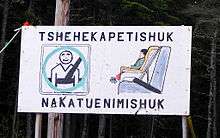Innu language
| Montagnais | |
|---|---|
| Innu-aimun | |
| Native to | Canada |
| Region | Quebec, Labrador |
| Ethnicity | Innu |
Native speakers | 11,000 (2011 census)[1] |
Early forms |
Old Montagnais
|
| Language codes | |
| ISO 639-3 |
moe |
| Glottolog |
mont1268[2] |
| Linguasphere |
62-ADA-bb |
Innu-aimun or Montagnais is an Algonquian language spoken by over 10,000 Innu[1] in Labrador and Quebec in Eastern Canada. It is a member of the Cree–Montagnais–Naskapi dialect continuum and is spoken in various dialects depending on the community.
Literature

In recent years, Innu-aimun has had considerable exposure in the popular culture of Canada and France due to the success of the rock music band Kashtin and the later solo careers of its founders Claude McKenzie and Florent Vollant. Widely heard hit songs with Innu-language lyrics have included Ish-kuess ("Girl"), E Uassiuian ("My Childhood"), Tipatshimun ("Song of the devil") and in particular Akua tuta ("Take care of yourself"), which appeared on soundtrack compilations for the popular television series Due South and the documentary Music for The Native Americans. The lyrics of Akua Tuta are featured on over 50 websites, making this one of the most broadly accessible pieces of text written in any native North American language. Florent Vollant has also rendered several well-known Christmas carols into Innu in his 1999 album Nipaiamianan.[3]
In 2013, "a comprehensive pan-Innu dictionary, covering all the Innu dialects spoken in Quebec and Labrador [was] published in Innu, English and French."[4]
Phonology
Innu-aimun has the following phonemes (written using the standard orthography, with IPA equivalents in brackets):
| Bilabial | Alveolar | Post- alveolar |
Velar | Glottal | ||
|---|---|---|---|---|---|---|
| plain | labial | |||||
| Nasal | m /m/ | n /n/ | ||||
| Plosive | p /p/ | t /t/ | tsh /tʃ/ | k /k/ | kᵘ/ku /kʷ/ | |
| Fricative | ss /s/ | sh /ʃ~s/ | (h /h/) | |||
| Lateral | (l /l/) | |||||
/l/ is written as n in standard orthography and only exists in the western dialects Mashteuiatsh and Betsiamites. Other dialects use /n/ in those positions.[5]
The voiceless plosive are voiced to [b d j ɡ ɡʷ] between vowels.
- Long vowels: î /i/, e /e~ɛ/, â /a/, û /o/
- Short vowels: i /ɪ~ə/, a /ʌ~ə/, u /o~ʊ~u/
- The circumflex accents over the long vowels are omitted in general writing.
Grammar
Innu-aimun is a polysynthetic, head-marking language with relatively free word order. Its three basic parts of speech are nouns, verbs, and particles. Nouns are grouped into two genders, animate and inanimate, and may carry affixes indicating plurality, possession, obviation, and location. Verbs are divided into four classes based on their transitivity: animate intransitive (AI), inanimate intransitive (II), transitive inanimate (TI), and transitive animate (TA). Verbs may carry affixes indicating agreement (with both subject and object arguments), tense, mood, and inversion. Two different sets, or orders, of verbal affixes are used depending on the verb's syntactic context. In simple main clauses, the verb is marked using affixes of the independent order, whereas in subordinate clauses and content-word questions, affixes of the conjunct order are used.
Dialects
Innu-aimun is related to East Cree (Īyiyū Ayimūn - Northern/Coastal dialect and Īnū Ayimūn - Southern/Inland dialect) spoken by the James Bay Cree of the James Bay region of Quebec and Ontario and the Atikamekw (Nēhinawēwin and Nehirâmowin) of the Atikamekw (‘Nehiraw’, ‘Nehirowisiw’). Innu-aimun is divided into four dialects - Southern Montagnais (Mashteuiatsh and Betsiamites), Eastern Montagnais (Mingan, Natashquan, La Romaine, Pakuashipi), Central Montagnais (Sept-Iles and Maliotenam, Matimekosh) and Labrador -Montagnais (Sheshatshit).[6] The speakers of the different dialects can communicate well with each other. The Naskapi language and culture are quite different from those of the Montagnais,[7] in which the dialect changes from y to n as in "Iiyuu" versus "Innu".
References
- Clarke, Sandra. 1982. North-West River (Sheshatshit) Montagnais: A grammatical sketch. National Museum of Man Mercury Series, 80. Ottawa: National Museums of Canada.
- Clarke, Sandra, and Marguerite MacKenzie. 2005. Montagnais/Innu-aimun (Algonquian). In Geert Booij et al. (eds.), Morphology: An international handbook on inflection and word formation, vol. 2, 1411–1421. Berlin; New York: Walter de Gruyter.
- Clarke, Sandra, and Marguerite MacKenzie. 2006. Labrador Innu-aimun: An introduction to the Sheshatshiu dialect. St. John's, Newfoundland: Department of Linguistics, Memorial University of Newfoundland.
- Drapeau, Lynn (1991) Dictionnaire montagnais-français. Québec: Presses de l'Université du Québec. 940 p.
Notes
- 1 2 Montagnais at Ethnologue (18th ed., 2015)
- ↑ Hammarström, Harald; Forkel, Robert; Haspelmath, Martin; Bank, Sebastian, eds. (2016). "Montagnais". Glottolog 2.7. Jena: Max Planck Institute for the Science of Human History.
- ↑ "Kashtin". realduesouth.net. Archived from the original on July 31, 2010. Retrieved 2013-09-25.
- ↑ Dooley, Danette (2013-09-21). "Linguistic defender". The Telegram. St. John's, Newfoundland. Retrieved 2013-09-25.
- ↑ "The process of spelling standardization of Innu-aimun (Montagnais)" (PDF)., p. 208
- ↑ Sometimes the dialects are also grouped as follows: Nehilawewin (Western Montagnais, Piyekwâkamî dialect), Leluwewn (Western Montagnais, Betsiamites dialect), Innu-Aimûn (Eastern Montagnais)
- ↑ "Montagnais and Naskapi – FREE Montagnais and Naskapi information | Encyclopedia.com: Find Montagnais and Naskapi research". www.encyclopedia.com. Retrieved 2016-07-31.
External links
- Online pan-Innu dictionary
- Innu-aimun.ca Information about the language.
- Innu Aimun orthography and phonology (Languagegeek)
- Native Languages page for Montagnais Innu
- OLAC resources in and about the Montagnais language
